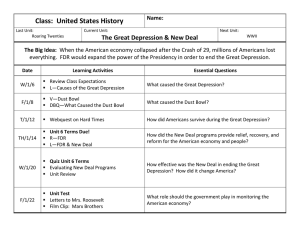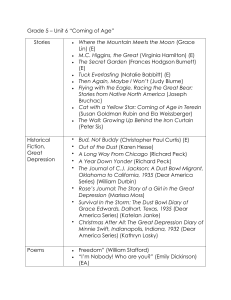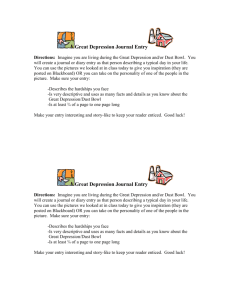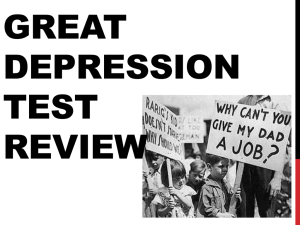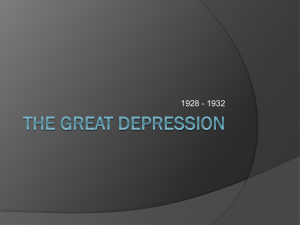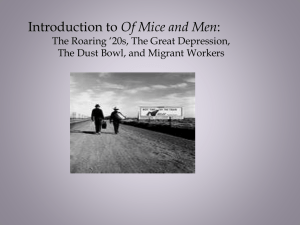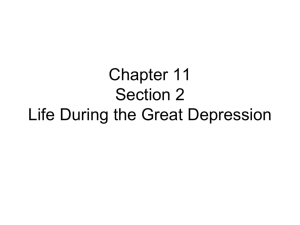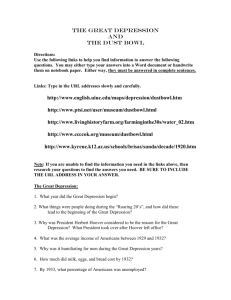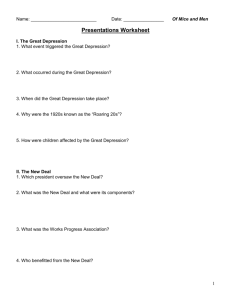Life During the New Deal (pgs. 365 – 370) Read the “Inside Story
advertisement
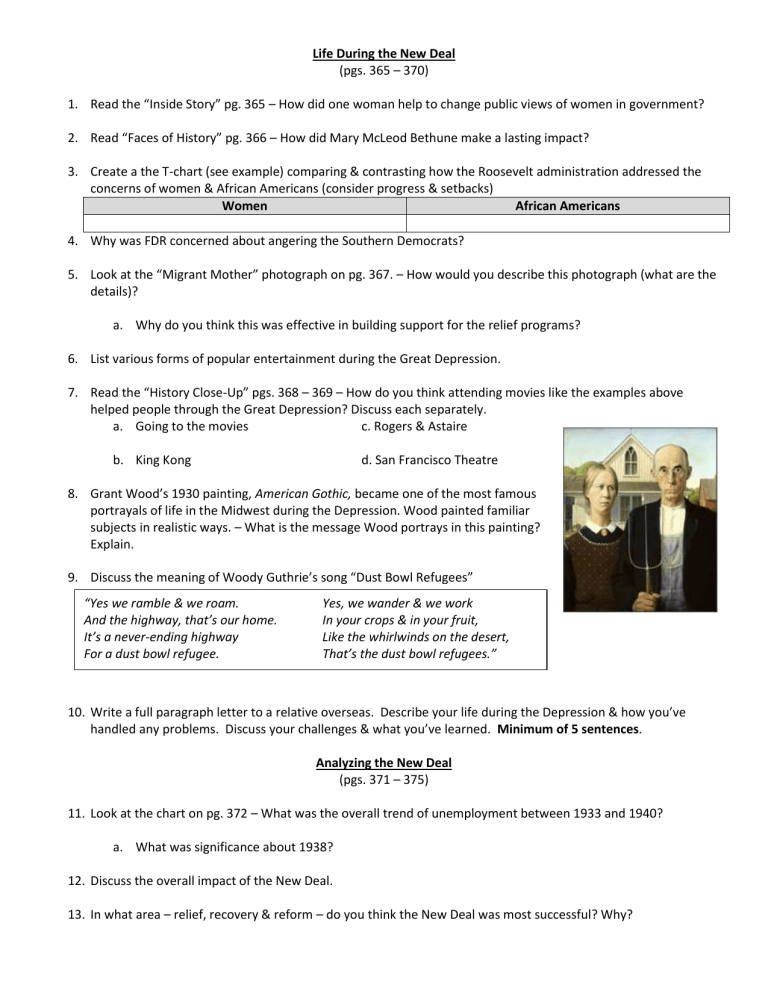
Life During the New Deal (pgs. 365 – 370) 1. Read the “Inside Story” pg. 365 – How did one woman help to change public views of women in government? 2. Read “Faces of History” pg. 366 – How did Mary McLeod Bethune make a lasting impact? 3. Create a the T-chart (see example) comparing & contrasting how the Roosevelt administration addressed the concerns of women & African Americans (consider progress & setbacks) Women African Americans 4. Why was FDR concerned about angering the Southern Democrats? 5. Look at the “Migrant Mother” photograph on pg. 367. – How would you describe this photograph (what are the details)? a. Why do you think this was effective in building support for the relief programs? 6. List various forms of popular entertainment during the Great Depression. 7. Read the “History Close-Up” pgs. 368 – 369 – How do you think attending movies like the examples above helped people through the Great Depression? Discuss each separately. a. Going to the movies c. Rogers & Astaire b. King Kong d. San Francisco Theatre 8. Grant Wood’s 1930 painting, American Gothic, became one of the most famous portrayals of life in the Midwest during the Depression. Wood painted familiar subjects in realistic ways. – What is the message Wood portrays in this painting? Explain. 9. Discuss the meaning of Woody Guthrie’s song “Dust Bowl Refugees” “Yes we ramble & we roam. And the highway, that’s our home. It’s a never-ending highway For a dust bowl refugee. Yes, we wander & we work In your crops & in your fruit, Like the whirlwinds on the desert, That’s the dust bowl refugees.” 10. Write a full paragraph letter to a relative overseas. Describe your life during the Depression & how you’ve handled any problems. Discuss your challenges & what you’ve learned. Minimum of 5 sentences. Analyzing the New Deal (pgs. 371 – 375) 11. Look at the chart on pg. 372 – What was the overall trend of unemployment between 1933 and 1940? a. What was significance about 1938? 12. Discuss the overall impact of the New Deal. 13. In what area – relief, recovery & reform – do you think the New Deal was most successful? Why? 14. As a result of the New Deal, Americans began to look regularly to government for help. Do you think this is a good or bad trend? Why? 15. Read “Counterparts” pg. 373 – Why does McNary believe that Social Security is needed? a. Why does Reed oppose it? 16. In what ways was the New Deal limited? 17. Do you think Roosevelt should have pushed harder to end discrimination in New Deal programs? 18. Read the excerpt below on the “Deportation of Mexican Americans.” What ethical issues does this raise? Many Mexican Americans were long-time residents or citizens of the U.S. Others came during the 1920s to work on farms in Texas, California, & Arizona. Valued for their low-cost labor during the good times, these migrant workers became the target of hostility during the Great Depression. Many returned to Mexico willingly, while others were deported by the U.S. government. During the 1930s, as many as 400,000 persons of Mexican descent, many of them U.S. citizens, were deported to Mexico. 19. What is the significance of the Fair Labor Standards Act? 20. How did FDR’s efforts to get rid of disloyal Democrats backfire? 21. How did the New Deal come to an end? 22. Read the Point-Counterpoint. a. Write a paragraph (3 – 5 sentences) that summarizes the main points of how did the New Deal succeed as well as how it failed POINT COUNTERPOINT “The New Deal transformed the way American Many more problems have been created than government works” solved by the New Deal.” Supporters of the New Deal believe that it was Critics of the New Deal believe that it failed to successful. Many historians & journalists make this reach its goals. The historian Barton Bernstein judgment by using the economic criterion of creating accepted the goals of the New Deal but declared that jobs. The New Republic, for example, argued that the they were never met. To him, the New Deal “failed to shortcomings of the WPA “are insignificant beside the raise the impoverished, it failed to redistribute gigantic fact that it has given jobs & sustenance to a income, & it failed to extend equality.” minimum of 1,400,000 & a maximum of 3,300,000 In Senator Robert Taft’s opinion, “many more persons for five years. problems have been created than solved” by the New Some historians stress that the New Deal was more Deal. He maintained, “Whatever else has resulted than a temporary solution to a crisis. Professor A.A. from the great increase in government activity… it has Berle stated that “human beings cannot indefinitely be certainly had the effect of checking private enterprise sacrificed by millions to the operation of economic completely. This country was built up by the constant forces.” establishment of new business & the expansion of old According to the historian William Luechtenburg, businesses… In the last six years this process has “It is hard to think of another period in the whole come to an end because of government regulation & history of the republic that was so fruitful or of a crisis the development of a tax system which penalizes hard that was met with as much imagination.” work & success.” Senator Taft claimed that “The To Pulitzer Prize-winning historian Allan Nevins, the government should gradually withdraw from the New Deal was a turning point in which the U.S. business of lending money & leave that function to government assumed a greater responsibility for the private capital under proper regulation.” economic welfare of its citizens.

